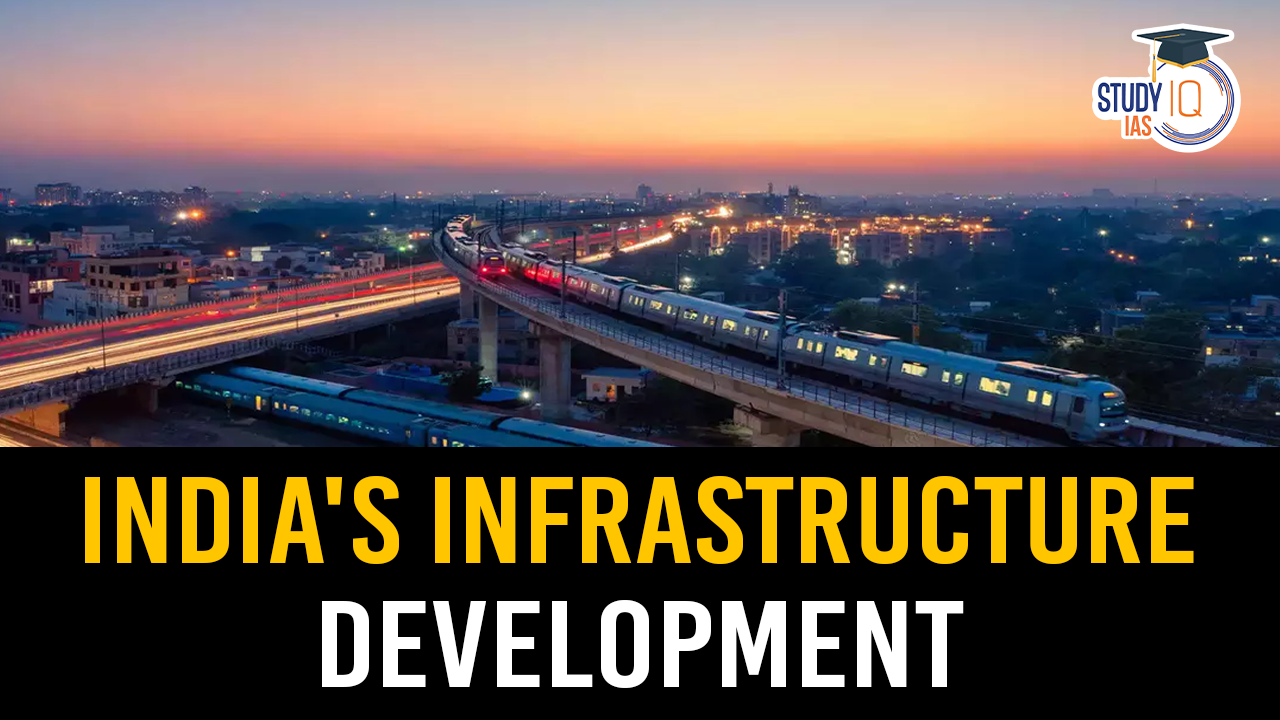Table of Contents
Context
Recent reports on the collapse of several under-construction bridges in Bihar highlight issues in quality control and project execution within India’s infrastructure sector.
More in News
- These collapses, involving as many as 10 or more bridges, raise concerns about the structural integrity of large-scale projects.
Introduction
- Infrastructure is a key driver of the Indian economy.
- Making India a developed nation by 2047 is linked to improvements in its infrastructure sector.
- Initiatives like PM Gati Shakti, National Logistics Policy, and Smart Cities Mission support this goal.
- In line with this vision, the government increased its capital expenditure allocation to ₹11.11 lakh crore (3.4% of GDP) in the 2024 Budget, indicating its commitment to infrastructure development.
- However infrastructure in India faces certain challenges and there is a need for improved project management practices to sustain India’s high growth trajectory.
Challenges within the Infrastructure Sector
- Time Delays and Cost Overruns: 431 infrastructure development projects, each with investments of ₹150 crore or more, faced cost overruns totaling ₹4.82 lakh crore as of December 2023 (according to a report by the Ministry of Statistics and Programme Implementation).
- Additionally, 779 delayed projects were noted, with delays ranging from 1 to over 60 months. The average project delay was three years.
- Multiple Clearances: Industrial and commercial projects in India require numerous clearances, leading to delays from conception to commissioning.
- Urban infrastructure projects suffer from poor project management, lack of comprehensive planning by local bodies, and insufficient capacity in local self-government institutions.
- Lack of Project Planning: Inadequate time and expertise devoted during the planning stage result in further delays and increased expenditure.
- Traditional Management Practices: Outdated project management techniques fail to incorporate modern tools for real-time data management and analysis, reducing the efficiency of project execution.
- Inadequate Human Resources: There is a shortage of skilled workers, engineers, and managers, which impacts the timely and effective development of social infrastructure projects like healthcare and education.
- Land Acquisition: Acquiring land for infrastructure projects is difficult due to resettlement issues and disputes over compensation, making it a time-consuming process.
Government Initiatives for Infrastructure Development
- PM Gati Shakti: The National Master Plan under PM Gati Shakti aims to bring various government ministries and departments together on an integrated platform.
- It uses a GIS-based ERP portal to monitor real-time progress and set benchmarks for departments.
- However, the success of the initiative also depends on project quality during implementation and the integrity of overseeing teams.
- National Infrastructure Pipeline (NIP): A massive ₹111 lakh crore initiative aimed at providing world-class infrastructure across sectors like energy, roads, railways, and urban development by 2025.
- It focuses on increasing investment from both public and private sectors.
| Significance of the National Infrastructure Pipeline (NIP) for Infrastructure Creation |
| ● Achieving India’s growth potential: The NIP is crucial for realising India’s goal of a $5 trillion
● economy by 2024-25, as infrastructure is a major constraint to growth. ● Boosting investor confidence: The NIP can enhance investor confidence by providing a pipeline of well-prepared and monitored projects, reducing the risk of non-performing assets (NPAs). ● Creating fiscal space: Improved infrastructure can stimulate economic activity, increase government revenue, and allow for more productive public spending. ● Ensuring better project implementation: The NIP can help ensure that infrastructure projects are adequately prepared, reducing the likelihood of delays and cost overruns. ● Strengthening rural infrastructure: The NIP includes significant investments in rural infrastructure, such as irrigation and rural roads, to support agricultural development. ● Improving connectivity: The NIP will enhance connectivity across India, especially in rural areas, through investments in road and railway infrastructure. |
- Smart Cities Mission: It is a flagship initiative launched by the Government of India in 2015 to transform 100 Indian cities into smart cities
- Also it aims to promote sustainable and inclusive urban development by focusing on citizen-friendly services, smart solutions, and better infrastructure.
- National Logistics Policy (NLP): It is a comprehensive framework aimed at improving India’s logistics infrastructure and creating an integrated logistics ecosystem.
- Reducing logistics costs: The policy seeks to reduce the cost of logistics from 13-14% of GDP to a global average of 8% by 2030.
- Improving logistics performance: The NLP aims to improve India’s ranking in the Logistics Performance Index, striving to be among the top 25 countries by 2030.
Major Plans of Indian Infrastructure |
| ● Roads – Bharatmala Pariyojana:
○ Phase I aims to develop 34,800 km of National Highways with a focus on corridor-based development. ○ Scheduled to conclude by 2027-2028, covering 31 States/UTs and over 550 districts. ○ The plan includes building 22 new greenfield expressways to enhance transportation infrastructure. ● Airports – UDAN (Ude Desh Ka Aam Nagarik): ○ Launched in 2016 to boost regional air connectivity, particularly to small towns. ○ In its first 5 years, UDAN launched 425 new routes and 58 airports, serving over one crore passengers. ○ The 2023-24 Budget allocated INR 1,244.07 Cr to UDAN, doubling the previous year’s budget. ○ Plans include reviving 22 airports and an additional 50 airports, heliports, water aerodromes, and landing grounds. ● Railways: ○ Major projects include the Mumbai-Ahmedabad Speed Rail Corridor and the Chenab bridge in Jammu & Kashmir (world’s highest railway bridge). ○ As of December 2023, 61,508 km of Broad Gauge network is electrified. ○ 35 Vande Bharat Express trains have been introduced, serving 247 districts, with 6 more trains to launch soon. ○ Indian Railways aims to become a Net Zero Carbon Emitter by 2030, with 211 MW of solar plants and 103 MW of wind power plants commissioned by October 2023. ● Ports – Sagarmala: ○ India’s ports have achieved a “Turn Around Time” of 0.9 days, better than countries like the USA (1.5 days) and Singapore (1.0 days), according to the World Bank’s LPI Report 2023. ○ Sagarmala promotes port-led development by leveraging India’s 7,500 km coastline and 14,500 km of potentially navigable waterways. ○ India’s total port capacity is expected to increase from 2,600 MTPA to over 10,000 MTPA by 2047. ○ Waterway cargo increased by 7.49% from April to November 2023, with plans to operationalise 23 waterways by 2030. |
Way Forward
- Current project management practices need modernization.
- The integration of real-time data management, analysis tools, and global best practices should be implemented in public sector and public-private partnership projects to improve efficiency.
- Program Management Approach is needed, as exemplified by the industrial corridor development projects such as Shendra-Bidkin in Aurangabad, Maharashtra.
- Proposal to set up a Project Management Agency to ensure effective project management.
- An agency should be established to conduct professional courses in project management, similar to the structure of the Institute of Chartered Accountants of India or chartered engineers in other countries.
- Such an institution would foster professional ethics, responsibilities, and monitoring capabilities in project execution, improving the overall infrastructure sector’s performance.
International Examples |
| ● Countries like the United Kingdom, China, and Saudi Arabia have adopted robust systems for managing large-scale projects.
● For instance, the UK’s Infrastructure and Projects Authority emphasises processes for project completion, while China and Saudi Arabia have set up agencies to oversee end-to-end project deliveries. |
Conclusion
With significant taxpayer money allocated to infrastructure, India must prevent time and cost overruns and ensure the structural integrity of its projects. Implementing a robust program management system will help build future-ready infrastructure and support India’s goal of becoming a global economic powerhouse by 2047.


 Utkal Divas 2025: Odisha Foundation Day ...
Utkal Divas 2025: Odisha Foundation Day ...
 List of Military Exercises of India 2024...
List of Military Exercises of India 2024...
 GPS Spoofing and Its Impact in India: A ...
GPS Spoofing and Its Impact in India: A ...





















